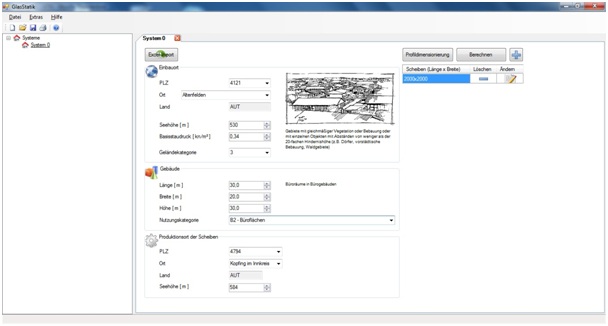2010/2011
Berechnungsprogramm für Glas- und Profilstatik
Jahrgang
Projektpartner
Josko Fenster und Türen GmbH
Maturanten
Ferihumer Fabian
5BI
Schöberl Daniel
5BI
Steiner Klaus
5BI
Betreuer

Oberaigner Günther

Zeller Rudolf
Problemstellung:
Es existierten aktuell lediglich Statik-Programme, die den eingegebenen Scheibenaufbau auf deren Zulässigkeit prüfen. Solche Programme sind außerdem mit hohen Lizenzkosten verbunden. Besser wäre eine automatische Dimensionierung, zumindest der äußeren Scheibe, basierend auf den Belastungswerten der österreichischen Normen. Um spezielle Effekte wie den Membraneffekt berücksichtigen zu können, muss die Dimensionierung mittels der Finite-Elemente-Methode realisiert werden.
Zielsetzung:
Es soll ein Programm entwickelt werden, welches unter Berücksichtigung der österreichischen Normen basierend auf den Belastungen und den Eingaben des Benutzers, Glasscheiben automatisch dimensioniert und Profile auf deren Gültigkeit berechnet. Dabei sind folgende Punkte zu realisieren:
· Übersichtliche und leicht bedienbare Oberfläche
· Berücksichtigung des Membraneffekts bei vierseitig gelagerten Scheiben und des Schubverbundes bei VSG-Scheiben
· Schnittstellen zu Excel-Dateien für den Import von System und zum Import bzw. Export von Profilen
· Erstellung eines druckbaren Berichts bzw. PDF-Export
· Datenspeicherung in einer Access-Datenbank
· Akzeptable Rechenzeiten
Projektablauf:
· Einarbeitung in die theoretischen Hintergründe
· Erstellung eines Oberflächenkonzeptes
· Erstellung der Datenbank und Anbindung an das Projekt
· Berechnung der Belastungswerte analog zu den Angaben der Normen
· Erstellung der für die FE-Berechnung notwendigen Matrizen
· Implementierung der Profilstatik-Berechnung
· Tests der Berechnungen durchführen
· Codierung der Finite-Elemente-Klasse
Ergebnis:
Folgende Punkte konnten im gegebenen Zeitraum realisiert werden:
· Entwicklung des Programms sowohl in C# als auch in C++ aufgrund der Plattformunabhängigkeit.
· Belastungswerte werden korrekt berechnet
· Speicherung aller Eingaben mittels XML-Serialisierung
· Vollständige Implementierung der Profilstatik
· Erstellung der Matrizen für die FE-Berechnung und Codierung der Berechnungsklasse
Die Berechnungsklasse konnte mangels Zeit leider nicht mehr getestet werden. Es wird deshalb versucht, das Programm nach der Matura fertigzustellen.
Verwertbarkeit:
Das Programm kann zurzeit für die Profidimensionierung verwendet werden, entspricht also dem Profilstatik-Programm von Sommer Informatik, welches mit Lizenzkosten verbunden ist.
Systembeschreibung:
Durch den Benutzer kann ein neues System angelegt oder ein bereits gespeichertes System geladen werden. Nach Eingabe der allgemeinen Informationen wie z.B. Einbauort bzw. Produktionsort der Glasscheibe, kann eine Glasscheibe hinzugefügt werden. Dazu müssen wieder alle notwendigen Informationen eingegeben werden (auch der Scheibenaufbau, jedoch nicht die Dicken) und die Belastungswerte werden automatisch berechnet. Außerdem können diese Werte auch manuell verändert werden, um spezielle Testfälle darzustellen. Mit den angelegten Glasscheiben kann die Profildimensionierung durchgeführt werden, bei der ein notwendiges Flächenträgheitsmoment errechnet wird. Die Berechnungsfunktion ist leider noch nicht einsatzbereit, es wären noch etwa 3 Monate Zeit für erste Tests notwendig gewesen.
Presentation of the problem:
Currently there only exist Programs which verify the manually defined glass plates. Furthermore such programs have very high license costs. A better way would be the automatic dimensioning of at least the outer plate under consideration of the Austrian standards and technical guidelines. To include effects like the membrane-effect and the shear resistance for laminated safety glass, it is necessary to use the finite element method.
Objectives:
We had to develop a program which automatically dimensions glass plates und consideration of Austrian standards and technical guidelines and also proofs the validation of profiles. Following points need to be implemented:
· Easy to use input masks
· Consideration of the membrane-effect and the shear resistance for laminated safety glass
· Interfaces to Microsoft Excel for importing systems and for import and export of profiles
· Results should be printable and exportable to a PDF-file
· Storage of data in a Microsoft Access-database
· Acceptable duration of calculations
Project schedule:
· Getting familiar with the theoretical backgrounds
· Input masks where created
· Creation of the database and implementation into the project
· Calculation of the loads analogue to the Austrian standards
· Creation of all matrices for the finite-element-method
· Implementation of the profile calculation
· Testing the calculations
· Encoding of the finite-element-method class
Results:
The following points had been realized:
· Developement of the whole interface in C# and C++. The project was realized in C++ due to its platform independency.
· Correct calculation of wind and climate load
· Storage of created systems using XML-Serialization
· Complete implementation of profile statics and administration of profiles
· Files necessary for the finite element calculation where created and stored
Due to less time we couldn´t finish the calculation class. For that reason we try to finish this program part and verify the results in summer.
Usability:
The program can be used for calculation of profiles and can be considered equal to the profile statics program from Sommer Informatik which has license costs.
Description:
The user can create a new system or load an existing one. After filling the general input mask, e.g. the production location, the user can create glass plates. For that the user again needs to fill in the necessary data and if correctly done the wind and climate load are calculated automatically. Furthermore the user can manually change these values. With a valid glass plate the profile calculation can be started. Therefore a necessary moment of inertia is calculated and compared to the given profiles. The function for automatically dimension the glass plates isn´t included yet because there wasn´t enough time left. We think there would be another 3 months time necessary to at least finish and verify the calculation.


